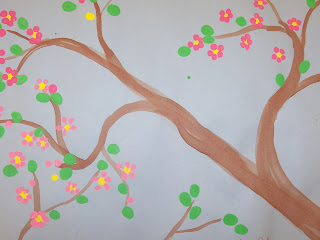Second grade students painted this branch of spring bloosoms for Mother's Day. Their classroom teacher adds poetry the children wrote. The finished prouduct is rolled up and tied with a ribbon, just like an Asian scroll.
When students walk in to the room, the lights are low and bamboo flute music is playing. In Asian culture painting is a form of meditation, so no one talks during work time. We use a bamboo brush and water color paints for the branch.
During the second class students paint the blossoms. I reuse styrofoam breakfast trays for the paints. The kids use a q-tip for the blossoms, and their finger for the green leaves. I find it helpful to remind them, they are not lining up the bloosms with the branches. They are creating an interesting
collection of blossoms (color). Objects in nature are random not orderly.
Since I already had the paint trays, I reused them for an extra first grade class the same afternoon. The first graders made a
still life. Students select a 9x12 background color, and a 9x3 table color to glue at the bottom. They make a vase by folding the paper and cutting lengthwise. After adding a pen outline and details, they sign their name and start painting. They found lots of interesting ways to make flowers. These were done in one class time!




































